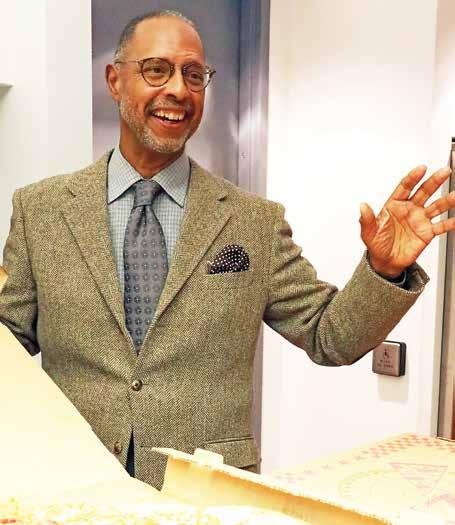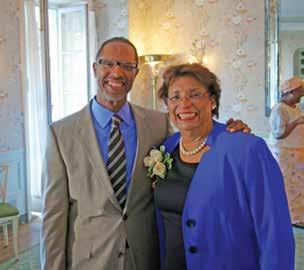
9 minute read
Serving Communities, from Patients to Students
Hotchkiss Gave Dr. John E. Ellis ’74 a ‘Wider Lens to the World’
BY JULIA ELLIOTT
Dr. Ellis threw himself into his studies on his first day at Hotchkiss in the fall of 1971, leading him on a long and successful journey of academia, medicine, and service. He served on the Hotchkiss Board of Trustees for a decade, and he is proud to support scholarship and financial aid opportunities for diverse students through his generous gifts.
GROWING UP IN QUEENS, NY, in the 1960s, Dr. John E. Ellis ’74 was always a gifted student. His childhood nickname was “the Brain,” and by the time he was 10 years old, he played chess, was proficient at trigonometry and, according to a 2007 article in The New York Times, was prone to lecture playground bullies on the Rev. Dr. Martin Luther King Jr.’s theory of nonviolence. In junior high, his favorite subjects were math and drama, and he hoped to continue studying both in high school. He considered attending the Bronx High School of Science, the city’s most selective high school for STEM, but at nearly two hours each way, the commute would have made it nearly impossible to find time for both of his passions.
Dr. Ellis’s parents, a corrections officer and a homemaker, emphasized education and were aware that elite boarding schools, which had begun recruiting and offering financial aid to minority students in earnest in the 1960s, would be a good option for their bright son. “The initial appeal,” he says, “was being able to engage my interests on a campus where I could walk five minutes from one thing to another.”
He applied to and was accepted at several of the very best New England boarding schools. On a visit back to Hotchkiss during the spring of 1971, he was intrigued that the School offered access to an IBM 1620 computer—a rarity at the time. What really cinched the deal, however, was his host, Franklin Salisbury ’74. “My main memory of that visit was Franklin’s warmth and the coziness of the school,” he says. He entered that fall as a lower mid and a recipient of the Watson Family Scholarship. Fifty years later, Dr. Ellis still has dinner with Salisbury whenever his classmate travels to Chicago.
Dr. Ellis enjoyed his math classes at Hotchkiss, especially sessions taught by George Norton Stone, whom he recalls as “rigorous, inspirational, and iconic.” In addition, he “thoroughly enjoyed the opportunity to program the IBM computer—using hole punch cards!” He found opportunities for camaraderie, hard work, and leadership through acting in several Hotchkiss theater productions. The drama teacher at the time, Jennifer Barrows, was a tremendous influence. “To this day, I can get up in front of a crowd of 800 people and be comfortable and engaging. I credit a lot of my experience as an educator and public speaker to her.”
His parents, particularly his father, believed in the importance of language and culture study. They encouraged him to spend his junior year in Barcelona, Spain. “There were 40 or 50 kids in the School Year Abroad program, and I was clearly among the best prepared in terms of language,” he says, crediting his Hotchkiss Spanish teacher, Ray Keck. His scholarship support continued as he studied abroad.
Dr. Ellis remains grateful for the opportunities Hotchkiss gave him. “The beautiful thing for me was I could do all the different things that interested me and have those impactful teachers.” He also acquired “a certain confidence walking into any room,” which he credits not only to the drama and study abroad programs, but also to the fact that “Hotchkiss gave me a wider lens on the world and a more open mind to entertain difference, whatever that might be.”
A Career in Medicine
In the fall of 1974, with multiple advanced classes under his belt (and the Hotchkiss math, chemistry, and Spanish prizes), he entered Harvard as a 16-year-old sophomore. He graduated with a major in biochemistry and headed off to the University of Chicago Pritzker School of Medicine.

It came as little surprise to his family that he gravitated toward anesthesiology during medical school. According to his sister, Tracy Ellis ’78, when the two played with bugs as children, “John would provide us with jars that held nail polish to sedate the insects.” He completed his residency at the University of Virginia, returned to the University of Chicago to complete a fellowship, and then joined the faculty there in 1987 as a cardiovascular anesthesiologist.
Dr. Ellis understands that, to some, anesthesiology means “you put the patient to sleep and then sit around and do nothing.” In his cardiovascular anesthesiology practice, however, he oversaw complicated surgeries, including liver transplants, major cancer operations, and repairs of aneurysms of the aorta. It was high-stakes medicine with steep intellectual and technical demands, and he loved the work. He especially enjoyed the “brief but intense opportunity to put patients at ease” and to help families through often stressful procedures.
In addition to his practice, Dr. Ellis researched drug therapies and techniques that might lessen the chance of heart attack after surgery. He also served on the Anesthetic and Analgesic Drug Products Advisory Committee to the U.S. Food and Drug Administration and participated in one contentious panel that resulted in a drug being withdrawn from the market. “It felt good to know I was serving the wellbeing of the public,” he says.
As a faculty member at the University of Chicago, he found teaching to be particularly rewarding. “One of the things that brings me joy is seeing my former residents 20 years later and hearing what they learned and took away from those experiences,” he says.
Anesthesiologists, especially one who is 6'2" like Dr. Ellis, are often putting their bodies into awkward positions to insert intravenous lines or peer down scopes. By 2006, he had undergone two operations to repair herniated disks in his neck. While the operations saved him from possible paralysis, the injuries led to his retirement from practicing anesthesiology in 2008.
Prior to retiring, he founded destinationCME with his sister, and they continue to produce medical education opportunities for anesthesiologists around the country. “It’s been a joy to continue to be involved in my specialty and watch it evolve,” he says. He also teaches as an adjunct professor at the University of Pennsylvania and is on the visiting faculty at the University of Miami. In addition, he served as vice president of the Society of Cardiovascular Anesthesiologists Research Foundation.
Along with Scott Meadow ’73, Dr. Ellis is a sitting member of the Investment Committee at Health Innovation Capital, a venture capital firm run by Andrew Meadow. “It has been wonderful to re-engage with Scott,” he says, “and it’s a way I can continue to both learn and teach.” Dr. Ellis is also an active volunteer, particularly in Chicago’s Hyde Park neighborhood, where he has lived for 40 years. He serves on the University of Chicago Alumni Board of Governors and the board of directors of the Hyde Park Jazz Festival.
Reconnecting with Hotchkiss
Roughly 20 years ago, Dr. Ellis reconnected with Hotchkiss through former Senior Associate Director of Admission Patricia Redd Johnson, who hoped he would speak at a Martin Luther King Jr. Day event. He eventually joined the Board of Trustees in 2005 and served until 2015. He chaired the Academic Matters Committee and, with Eleanor “Duffy” Green Long ’76, co-chaired the Head of


School search. He brought to both roles a deep knowledge of academic culture.
Dr. Ellis found the Hotchkiss board to be highly effective, in part due to the leadership of John Thornton ’72, P’10,’11,’16 and Jeannie Weinberg Rose ’80, P’18, but also because “people brought diverse skill sets and viewpoints.” He particularly valued interacting with students and the faculty. He is an avid collector of African American art and shares similar interests with artist and fellow New Yorker Eilen Itzel Mena ’13, who is of Dominican descent. “She said it made her feel good to see someone who looked like her on the Board of Trustees, and that was gratifying to me,” Dr. Ellis says. He helped fund Mena’s February 2022 exhibit at the Tremaine Art Gallery and residency in the School’s studio art and Diversity, Equity, and Inclusion departments.
Dr. Ellis deepened his friendship with Johnson during his tenure on the Board. When her retirement party was announced, he cut short a planned trip to Turkey to attend. “Pat was an admission officer, but she was much more than that. She worked tirelessly to support students of color and really touched so many lives.” When the Pat Redd Johnson Scholarship was announced, he immediately became a supporter.
He also contributes to the Walter J.
Crain Jr. P’86,’89 Scholarship in memory of Hotchkiss’s first Black faculty member. “For me it’s important that you have people of color as mentors to all young people. My fellow Hotchkiss board members and other white alumni know that Walter Crain was instrumental in their development as adolescents. That is as important as Pat Redd Johnson being a mentor to generations of students of color.”
As a member of the Town Hill Society, which recognizes those who have named Hotchkiss in their estate plans, Dr. Ellis is particularly proud to support financial aid. “Hotchkiss is enriched by having talented students from all over the country and different parts of the world. That rich diversity is important, and to the extent that financial aid facilitates that, it’s great,” he says. “Obviously, I wouldn’t have been able to go to Hotchkiss without financial aid. Hotchkiss was instrumental in what I have been able to do, and I want others to have the opportunity to have similar experiences as I have. My giving is modest, but every bit helps. There is nothing more important than having a talented student body, followed close second by having a talented faculty.”









